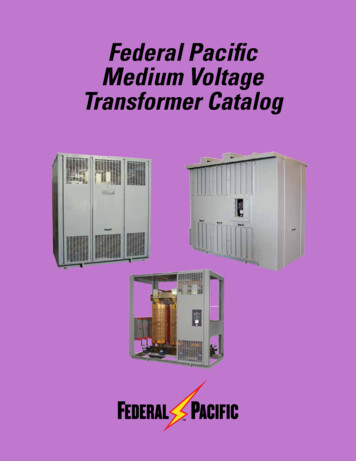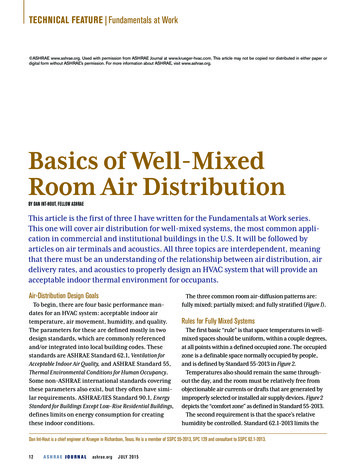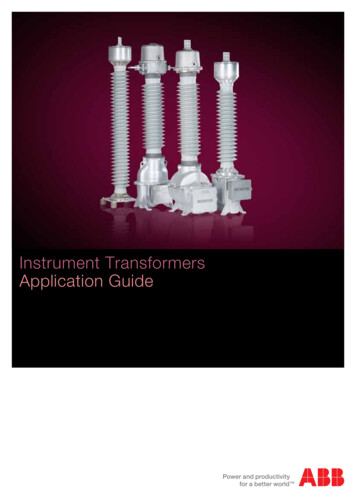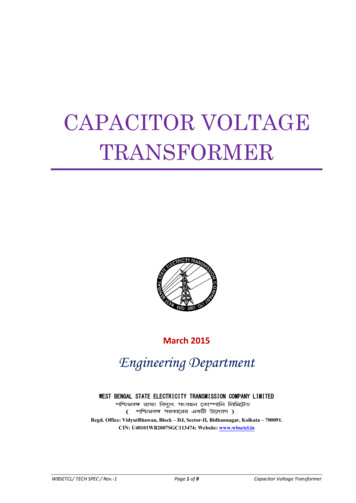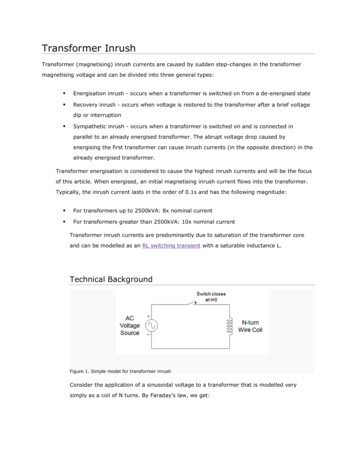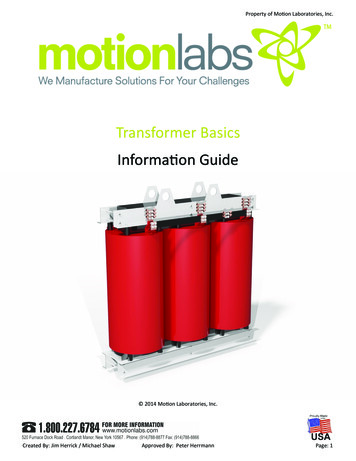
Transcription
Property of Motion Laboratories, Inc.Transformer BasicsInformation Guide 2014 Motion Laboratories, Inc.Created By: Jim Herrick / Michael ShawApproved By: Peter HerrmannPage: 1
Transformer DefinitionAn electric device consisting essentially of two or morewindings, wound on a common core,which by electromagnetic induction transferselectric energy from one set of windings (primary) to another set ofwindings (secondary). In addition to the “basic” transformer design,there are other specialty configurations, such as, Buck/Boost, whichare described in Types & Uses.While the voltage and current usually change (from primary tosecondary), the frequency of the energy remains unchanged.Transformers only work on alternating current (not direct current).The voltage change is determined by the ratio of turns of wirearound the core, between the primary and secondary windings. 2014 Motion Laboratories, Inc.Page: 2
Information Guide Transformer BasicsTable Of Contents1.Normal Types & Uses2.Multiple Taps3.Reverse Connected4.Metering5.Single Phase6.Three Phase7.Delta / Wye (3-Phase)8.Hertz (Hz)9.International Considerations10. What a Transformer Can’t Do11. KVA12. Separately Derived Neutral / Ground Bond13. Overload (Over-Current) Protection14. Load Balancing15. Sizing a TransformerPage: 3
Information Guide Transformer Basics1. Normal Types & UsesIsolation onlyDoes not change voltage. It does, however, provide isolation from the facilities electricalsystem, which eliminates much of the buildings electrical “noise” on the output.Step downChanges a higher voltage to a lower voltage, such as 480V to 208V, and provides isolation.Step upChanges a lower voltage to a higher voltage, such as 240V to 480V, and provides isolation.Note: In most cases the transformers (describe above) that provide isolation also incorporatea grounded “Faraday Shield”, between the primary and secondary windings, to reduce thetransmittance of high frequency “noise”. Although shielding is generally included, it should bespecified.Buck/BoostNormally used when only a small change in voltage is required (20% or less), such as 208V to240V (Boost) or 240V to 208V (Buck). This type system does not provide isolation, but is morecost effective if isolation is not required. A Buck/Boost transformer is also referred to as an“Auto Transformer”. On an “Isolation transformer” there is no direct electrical connectionbetween the primary and secondary (Only magnetic / inductive), such is not the case with aBuck/Boost unit, therefore there is no isolation.2. Multiple TapsIn order to accommodate various input voltages, some transformers may be equipped withmultiple taps on the primary. These taps are sized for standard voltages (220, 230, 240 .etc.),or they can be only slight variations to adjust for consistent over or under voltage at aparticular location. These taps are most commonly provided as a percentage of the primaryvoltage, such as 2-1/2% and 5% (up or down from nominal).(Primary Voltage/Tap Voltage Setting) X Expected Secondary Voltage Actual Output VoltageFor Example: Given a 480V to 208V Delta Wye, with an input voltage of 460V and a tap setfor 480V would yield: (460/480) X 208 199.33V. In order to yield 208V this tap setting wouldbe insufficient. You would have to use a tap setting that was lower, such as 456V.Page: 4
Information Guide Transformer Basics3. Reverse ConnectedMost transformers can be “reverse connected” which means the same transformer can bewired to be a “step-up” or “step-down, depending on how it’s installed. This reversingcapability must be allowed and specified by the manufacturer.If a transformer connection is rearranged from step up to step down or step down tostep up, careful attention must be paid to the neutral/ground bonding which can onlybe on the output side of the transformer.4. MeteringAlthough not absolutely required, it is recommended that an integral meter panel beinstalled in, or adjacent to, the transformer enclosure. This will allow constant monitoring ofsystem performance, and let you know if the required voltage is present and that the systemis not being overloaded.5. Single PhaseA transformer that is fed, on the primary winding, by a single alternating voltage, which canbe represented by a single sine wave. The secondary winding can be “split” or “tapped”, toproduce multiple voltages, such as, 120/240V.Page: 5
Information Guide Transformer Basics6. Three PhaseA transformer that is fed, on the primary windings, by three equal alternating voltages, thetiming of which are 120 degrees “out of phase” with each other. A typical application wouldbe 480V input with 120/208V output, where the grounded conductor (neutral) on the 120Voutput is common with all three lines (Phases).A three phase transformer can be constructed either by connecting together three singlephase transformers, thereby forming a so-called three phase transformer bank, or by usingone pre-assembled, three phase transformer which consists of three pairs of single phasewindings mounted onto one single laminated core.The advantages of building a single three phase transformer is that for the same kVA rating itwill be smaller, less expensive, and lighter than three individual single phase transformersconnected together because the copper and iron core are used more effectively.Page: 6
Information Guide Transformer Basics7. Delta / Wye (3-Phase)There are two types of circuits used to maintain equal load across the three hot wires in a 3phase system—Delta and Wye. The Delta configuration has the three phases connected like atriangle, whereas the Wye (or “star”) configuration has all three loads connected at a singleneutral point. In most cases Delta systems have four wires—three hot and one ground. Wyesystems have five wires—three hot, one neutral and one ground. While both Delta and Wyesystems can measure 208VAC (on the secondary) between any two hot wires, Wye systemsalso measure 120VAC between any hot wire and neutral. In other words, it’s the neutral wireof the Wye system that provides two different voltages for powering both 3-phase (208V)and single-phase (120V) devices.TypesThe most common 3-phase configuration is: Delta Wye, (Depicted below),Page: 7
Information Guide Transformer Basics7. Delta / Wye (3-Phase) (Continued )In addition, there are other configurations available, such as:Delta Delta, used when a neutral is generally not required on the secondary. If asecondary neutral is provided, it is termed a “High Leg” system, since one of the legs(referenced to ground), would be in excess of 200V. It is not recommended that a neutral beprovided with a Delta secondary, since the “High Leg” can cause equipment damage if notconnected properly.Wye Wye, in this case a neutral is not required on the primary, however this is a moreexpensive configuration, without any benefit other than being able to rearrange input andoutput. (As described in Section 3)Wye Delta, This configuration is not recommended, due to its instability with unbalancedloads and it contributes to additional harmonic content.8. Hertz (Hz)Also termed “Cycles per Second” or “Frequency”. With relation to sine waves, it’s the time ittakes for one complete cycle. In North America the frequency is 60Hz, in most of Europe it’s50Hz.Transformers must be specified at which frequency they will be used.A transformer that is rated at 50Hz will also operate at 60Hz, however the inverse is not true:A 60Hz rated transformer cannot operate at 50Hz, unless de-rated at least 20% to allow forexcessive heating effects.This is NOT recommended and these applications require a transformer rated for50hz/60hz.Page: 8
Information Guide Transformer Basics9. International ConsiderationsDifferent countries have different standard voltages depending on the location. In most ofEurope the standard voltages include 380V & 415V, but this may vary considerably. It isdifficult, if not impossible, to get a transformer with all the possible voltages you mayencounter, and additionally more difficult to get one that has both North American andEuropean voltages on the same transformer.In some cases a “custom wound” transformer can be manufactured, but it is generally costprohibitive.10. What Transformers Can’t DoCorrect Voltage Fluctuations: Transformers are “proportional” devices. The input / outputratio remains the same regardless of the variations in input voltage. As an example: a 2:1ratio transformer with a 240V primary, will produce 120V on the secondary. If the primaryvoltage is changed to 250V, the secondary voltage would be 125V.Change Frequency: Whatever frequency is on the primary will appear on the secondary.Produce More “Power”: In simple terms, power is defined as “WATTS”. Watts are Volts XAmps. In this case, Volts and Amps are “inversely proportional”, which means if you gain Voltsyou’re going to lose Amps; if you gain Amps you’re going to lose Volts. As an example:With a secondary of 100A @240V, the required primary amperage would be 200A @ 120V.No power (Watts) was gained: 100A X 240V 24,000W [same as] 200A X 120V 24,000W.Page: 9
Information Guide Transformer Basics10. What Transformers Can’t Do (Continued )Change single phase to 3-phase: A Single phase transformer primary can be supplied by 2 ofthe line conductors, of a 3-phase system, however the output (secondary) will be singlephase.3-phase outputs require 3-phase inputs.11. KVATo put it simply, VA (Volt Amps) is directly related to Watts. 1 KVA is equal to 1000VA. In mostcases transformers are rated in KVA, This is one of the most important parts of thetransformer specification.KVA is determined by the connected load of your equipment. The primary KVA and thesecondary KVA are exactly the same. As an example:100A @ 120V 12,000VA or 12KVA [same as] 50A @ 240V 12,000VA or 12KVA.KVA calculations for 3-Phase transformers is not quite as simple, and will be explained insection 15.12. Separately Derived Neutral / Ground BondOne of the important functions of an isolation transformer is that it establishes a newneutral / ground bond point.This is referred to as a “Separately Derived System”. There are only two places that a neutraland ground are permitted to be connected together, (1) In the main service panel and (2) atthe source of a separately derived system. This new bond eliminates any “noise” on theneutral, ground, and to some extent the line conductors, from entering the power providedby the transformer and subsequently getting into equipment connected to the secondary ofthe transformer.Page: 10
Information Guide Transformer Basics13. Overload (Over-Current) ProtectionPrimary: Overload protection or Circuit Breaker (CB) is always required. It may be sized noless than 100% of the current draw on the primary and no more than 125%, unless there isoverload protection on the secondary. If such is the case, the primary CB may be increasedup to 250%.For Example: If there were a overload protected 400A feeder on the input side (primary)connected to a 100A rated transformer primary, a primary CB would be required in thetransformer, since this arrangement could “possibly” feed this 100A transformer with 400A.This would be 400%, exceeding the 250% maximum allowed. If however, a transformer had a200A rated primary, the primary CB would not be required, since the 250% would not beexceeded.Secondary: Overload protection is not always required, however, if the primary CB is sizedmore than 125%, then secondary protection is required, sized no more than 125% of themaximum secondary capacity. Secondary protection can take the form of several (no morethan 6) CBs, as long as the total amperage of all the CBs (added together) does not exceed125% of the secondary capacity.Location: The primary and/or secondary overload protection does not have to be in acommon enclosure with the transformer. As a typical example, a “house breaker” can serveas primary protection, as long as the percentages, described above, are followed and theprimary disconnect is within 50 feet & in sight of the transformer location or the disconnect islockable.Note: On Portable Systems If you are unsure of what you’re going to encounter in the field, itis advisable to purchase a transformer system with primary and secondary protection,mounted in the transformer enclosure. In most cases the additional cost is justified.Conductors: The above overload protection requirements apply to transformers only,and not to the conductors that feed the transformer, or conductors going out to theload circuits. Requirements for the protection of conductors are not covered in thisdocument.Page: 11
Information Guide Transformer Basics14. Load BalancingWhen connecting load equipment, on the secondary of a transformer, it is best to “balance”the total load among the individual phases. You most likely cannot balance loads exactly,however, balanced (or nearly balanced) loads help prevent over-heating and reduceselectrical stress on the transformer. It is possible to overload individual phases withoutexceeding to the total KVA capacity of the transformer.15. Sizing a TransformerFrom an “end users” point of view, the following information is required before starting anycalculations:1. Is the system single or 3-phase?2. What is the frequency (Hz)?3. What is the voltage (line to line, not line to neutral) of the “house power” (primary)?4. What voltage is required for your load equipment (secondary)?5. What is the maximum total load (Amps) of your connected equipment (secondary)?With the above information, the KVA of the transformer can be calculated (below).Page: 12
Information Guide Transformer Basics15. Sizing a Transformer (Continued )IMPORTANT NOTES: The Volts and Amps, used in the calculations below, can be either thePrimary OR the Secondary, but not both (Don’t mix them). Remember, The KVA is the same inthe Primary and the Secondary. The “Volts” are the Line to Line, NOT the Line to Neutral.Single Phase Calculations:Example:Volts X Amps / 1000 KVA208V X 100A 20,800VA / 1000 20.8KVA.Three Phase Calculations:Example:Volts X Amps X 1.73 / 1000 KVA208V X 100A X 1.73 35,984VA / 1000 35.984KVAAfter determining the KVA, select a “standard” size transformer that is no less than the KVArequired.Page: 13
Information Guide Transformer BasicsNOTESPage: 14
hange single phase to 3-phase: A Single phase transformer primary can be supplied by 2 of the line conductors, of a 3-phase system, however the output (secondary) will be single phase. 3-phase outputs require 3-phase inputs. 11. KVA To put it simply, VA (Volt Amps) is dir


